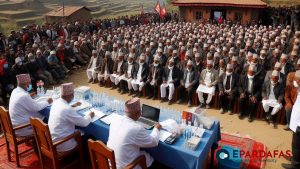
Earthquake Safety Day: DPM Shrestha advocates collaborative disaster reduction efforts

Deputy Prime Minister and Home Minister Narayan Kaji Shrestha has emphasized the need for collaborative efforts in disaster reduction and local resilience.
During a program organized by the Kathmandu Metropolitan City (KMC) at Bhugol Park in Kathmandu on Earthquake Safety Day, he called for cooperation among all three tiers of government.
DPM Shrestha highlighted the potential of the collaboration between KMC, federal, and provincial governments, suggesting it could serve as a model for other local levels.
He reminded that disaster management is a right mentioned in the constitution for local governments, emphasizing the shared responsibility to address related challenges.
“The federal government is ready to collaborate with local levels for their capacity building,” said DPM Shrestha, mentioning that local levels have been provided with equipment for emergency and rescue operations through the National Disaster Risk Reduction and Management Authority.
Acknowledging the significant role of volunteers in effective disaster management, DPM Shrestha proposed integrating volunteers into a national system. He commended KMC’s mobilization of volunteers, training initiatives, and assistance provided in the aftermath of the Jajarkot Earthquake.
Expressing happiness over KMC’s efforts, DPM Shrestha encouraged the replication of KMC’s initiatives by other local levels. He specifically praised KMC’s role in enforcing building codes for earthquake safety and assessing and retrofitting unsafe structures.
Deputy Mayor of KMC, Sunita Dangol, stressed the importance of building quake-resistant structures and advocated for the utilization of locally available resources and technology to strengthen infrastructure.
She highlighted the need for enhanced collaboration and coordination among all three tiers of government.
Earthquake Safety Day is observed annually on Magh 2 of the Nepali calendar since 2055 BS, commemorating the devastating earthquake that occurred on Magh 2, 1990 BS.
The earthquake measured 8.4 on the Richter scale and claimed numerous lives and properties.
Senior seismologist Lok Bijay Adhikari informed that 8,519 Nepalis died, 80,000 houses were destroyed, and a total of 207,248 structures perished in the 1990 BS earthquake.
The Gurkha Earthquake of Baisakh 12, 2072 BS, claimed 8,670 lives and destroyed over 700 thousand houses, marking another significant earthquake in Nepal’s recent history.
- Bangladeshi Ambassador Salahuddin Noman Chowdhury Meets Energy Minister Dipak Khadka to Discuss Bilateral Energy Cooperation
- Foreign Minister Dr. Arzu Rana Deuba to Attend Women Foreign Ministers’ Meeting in Canada
- CIAA Submits Fiscal Year 2080/81 Report to President Paudel
- Nepal-US Joint Military Drill on Post-Disaster Response Begins












Comments